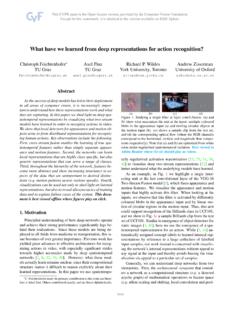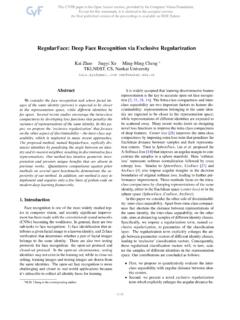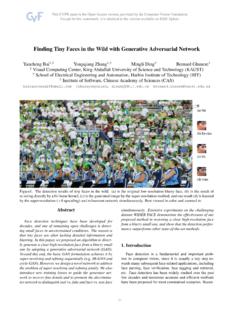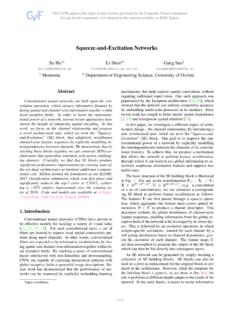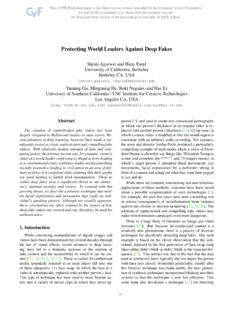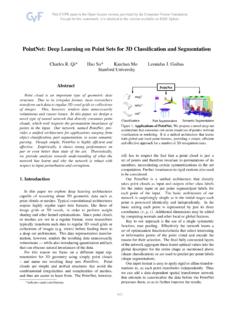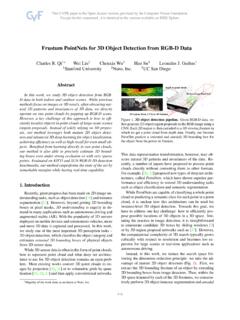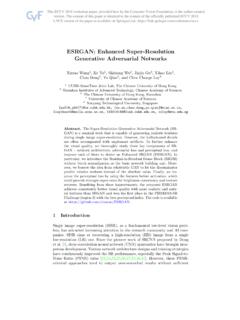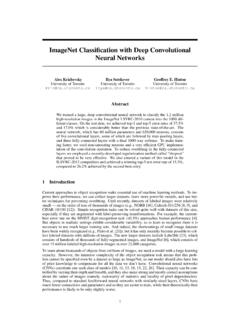Transcription of Class-Balanced Loss Based on Effective Number of Samples
1 Class-Balanced Loss Based on Effective Number of SamplesYin Cui1,2 Menglin Jia1 Tsung-Yi Lin3 Yang Song4 Serge Belongie1,21 Cornell University2 Cornell Tech3 Google Brain4 Alphabet the rapid increase of large- scale , real-worlddatasets, it becomes critical to address the problem of long-tailed data distribution ( , a few classes account for mostof the data, while most classes are under-represented). Ex-isting solutions typically adopt class re-balancing strategiessuch as re-sampling and re-weighting Based on the numberof observations for each class. In this work, we argue thatas the Number of Samples increases, the additional benefitof a newly added data point will diminish. We introducea novel theoretical framework to measure data overlap byassociating with each sample a small neighboring regionrather than a single point.
2 The Effective Number of samplesis defined as the volume of Samples and can be calculatedby a simple formula(1 n)/(1 ), wherenis the numberof Samples and [0,1)is a hyperparameter. We design are-weighting scheme that uses the Effective Number of sam-ples for each class to re-balance the loss, thereby yieldingaclass-balanced loss. Comprehensive experiments are con-ducted on artificially induced long-tailed CIFAR datasetsand large- scale datasets including ImageNet and iNatural-ist. Our results show that when trained with the proposedclass-balanced loss, the network is able to achieve signifi-cant performance gains on long-tailed IntroductionThe recent success of deep Convolutional Neural Net-works (CNNs) for visual recognition [26,37,38,16] owesmuch to the availability of large- scale , real-world anno-tated datasets [7,28,49,41].]
3 In contrast with commonlyused visual recognition datasets ( , CIFAR [25,40], Ima-geNet ILSVRC 2012 [7,34] and CUB-200 Birds [43]) thatexhibit roughly uniform distributions of class labels, real-world datasets have skewed [21] distributions, with along-tail: a few dominant classes claim most of the examples,while most of the other classes are represented by relativelyfew examples. Models trained on such data perform poorlyfor weakly represented classes [19,15,42,4]. The work was performed while Yin Cui and Yang Song worked atGoogle (a subsidiary of Alphabet Inc.).No re-weightingRe-weighted byinverse class frequencyRe-weighted byeffectivenumber ofsamplesEffective numberEffective number010002000300040005000 Sorted class index101102103 Numberof training samplesLong TailHeadFigure 1.
4 Two classes, one from the head and one from the tail ofa long-tailed dataset (iNaturalist 2017 [41] in this example), havedrastically different Number of Samples . Models trained on thesesamples are biased toward dominant classes (black solid line). Re-weighing the loss by inverse class frequency usually yields poorperformance (red dashed line) on real-world data with high classimbalance. We propose a theoretical framework to quantify theeffective Number of Samples by taking data overlap into consider-ation. A Class-Balanced term is designed to re-weight the loss byinverse Effective Number of Samples . We show in experiments thatthe performance of a model can be improved when trained withthe proposed Class-Balanced loss (blue dashed line).
5 A Number of recent studies have aimed to alleviate thechallenge of long-tailed training data [3,32,17,42,44,12,48,45]. In general, there are two strategies: re-samplingand cost-sensitive re-weighting. In re-sampling, the numberof examples is directly adjusted by over-sampling (addingrepetitive data) for the minor class or under-sampling (re-moving data) for the major class, or both. In cost-sensitivere-weighting, we influence the loss function by assigning19268relatively higher costs to examples from minor classes. Inthe context of deep feature representation learning usingCNNs, re-sampling may either introduce large amounts ofduplicated Samples , which slows down the training andmakes the model susceptible to overfitting when over-sampling, or discard valuable examples that are importantfor feature learning when under-sampling.
6 Due to these dis-advantages of applying re-sampling for CNN training, thepresent work focuses on re-weighting approaches, namely,how to design a better Class-Balanced , we assign sample weights or re-sample datainversely proportionally to the class frequency. This simpleheuristic has been widely adopted [17,44]. However, recentwork on training from large- scale , real-world, long-taileddatasets [31,29] reveal poor performance when using thisstrategy. Instead, they propose to use a smoothed versionthat empirically re- Samples data to be inversely proportionalto the square root of class frequency. These observationssuggest an interesting question: how can we design a betterclass-balanced loss that is applicable to a diverse array ofdatasets with drastically different scale and imbalance?
7 We aim to answer this question from the perspective ofsample size. As illustrated in Figure1, we consider traininga model to discriminate between a major class and a minorclass from a long-tailed dataset. Due to highly imbalanceddata, directly training the model or re-weighting the lossby inverse Number of Samples cannot yield satisfactory per-formance. Intuitively, the more data, the better. However,since there is information overlap among data, as the num-ber of Samples increases, the marginal benefit a model canextract from the data diminishes. In light of this, we proposea novel theoretical framework to characterize data overlapand calculate the Effective Number of Samples in a model-and loss-agnostic manner.
8 A Class-Balanced re-weightingterm that is inversely proportional to the Effective Number ofsamples is added to the loss function. Extensive experimen-tal results indicate that this Class-Balanced term provides asignificant boost to the performance of commonly used lossfunctions for training CNNs on long-tailed key contributions can be summarized as follows: (1)We provide a theoretical framework to study the effectivenumber of Samples and show how to design a class-balancedterm to deal with long-tailed training data. (2) We show thatsignificant performance improvements can be achieved byadding the proposed Class-Balanced term to existing com-monly used loss functions including softmax cross-entropy,sigmoid cross-entropy and focal loss.
9 In addition, we showour Class-Balanced loss can be used as a generic loss for vi-sual recognition by outperforming commonly-used softmaxcross-entropy loss on ILSVRC 2012. We believe our studyon quantifying the Effective Number of Samples and Class-Balanced loss can offer useful guidelines for researchersworking in domains with long-tailed class Related WorkMost of previous efforts on long-tailed imbalanced datacan be divided into two regimes: re-sampling [36,12,4,51](including over-sampling and under-sampling) and cost-sensitive learning [39,50,17,23,35]. adds repeated samplesfrom minor classes, which could cause the model to over-fit. To solve this, novel Samples can be either interpolatedfrom neighboring Samples [5] or synthesized [14,51] forminor classes.
10 However, the model is still error-prone due tonoise in the novel Samples . It was argued that even if over-sampling incurs risks from removing important Samples ,under-sampling is still preferred over over-sampling [9].Cost-Sensitive Learning canbe traced back to a classical method in statistics called im-portance sampling [20], where weights are assigned to sam-ples in order to match a given data distribution. Elkanetal. [10] studied how to assign weights to adjust the decisionboundary to match a given target in the case of binary clas-sification. For imbalanced datasets, weighting by inverseclass frequency [17,44] or a smoothed version of inversesquare root of class frequency [31,29] are often a generalization of smoothed weighting with a theoreti-cally grounded framework, we focus on (a) how to quantifythe Effective Number of Samples and (b) using it to re-weightthe loss.
